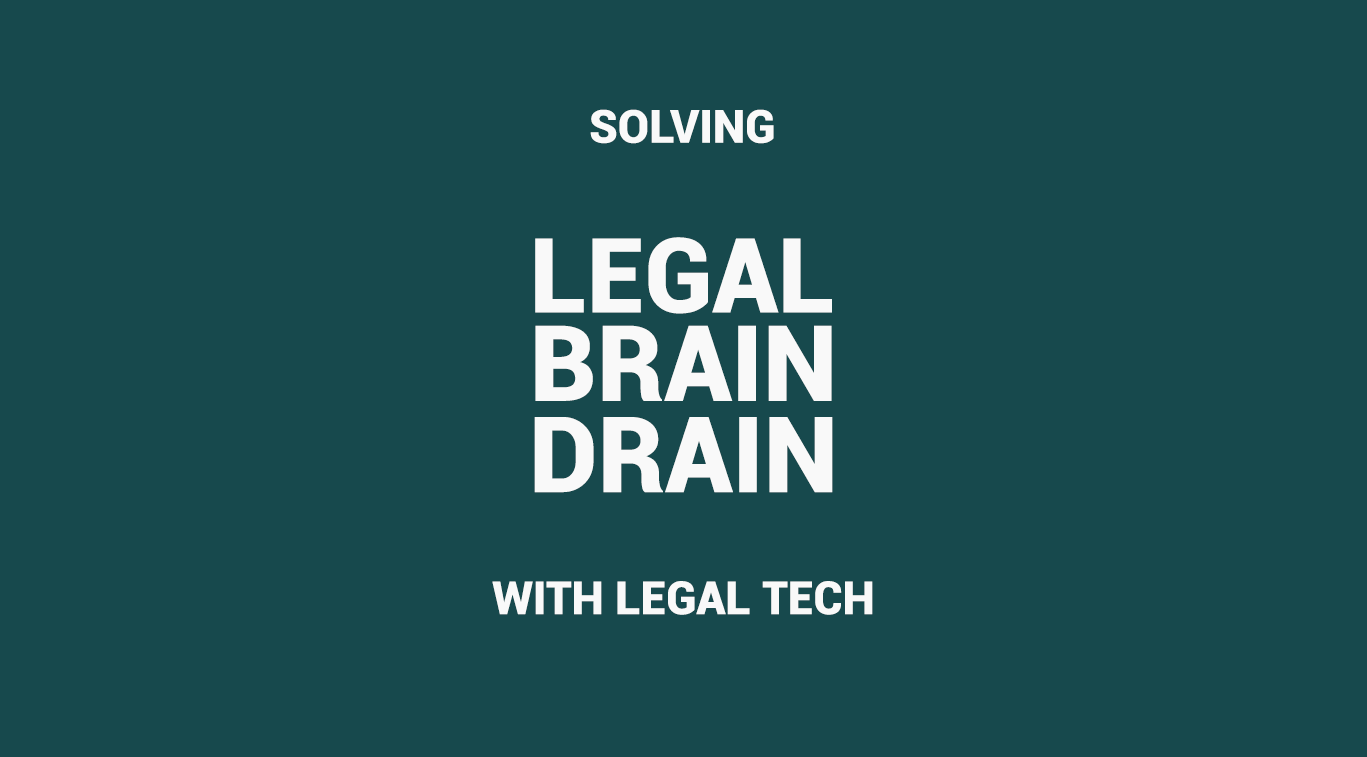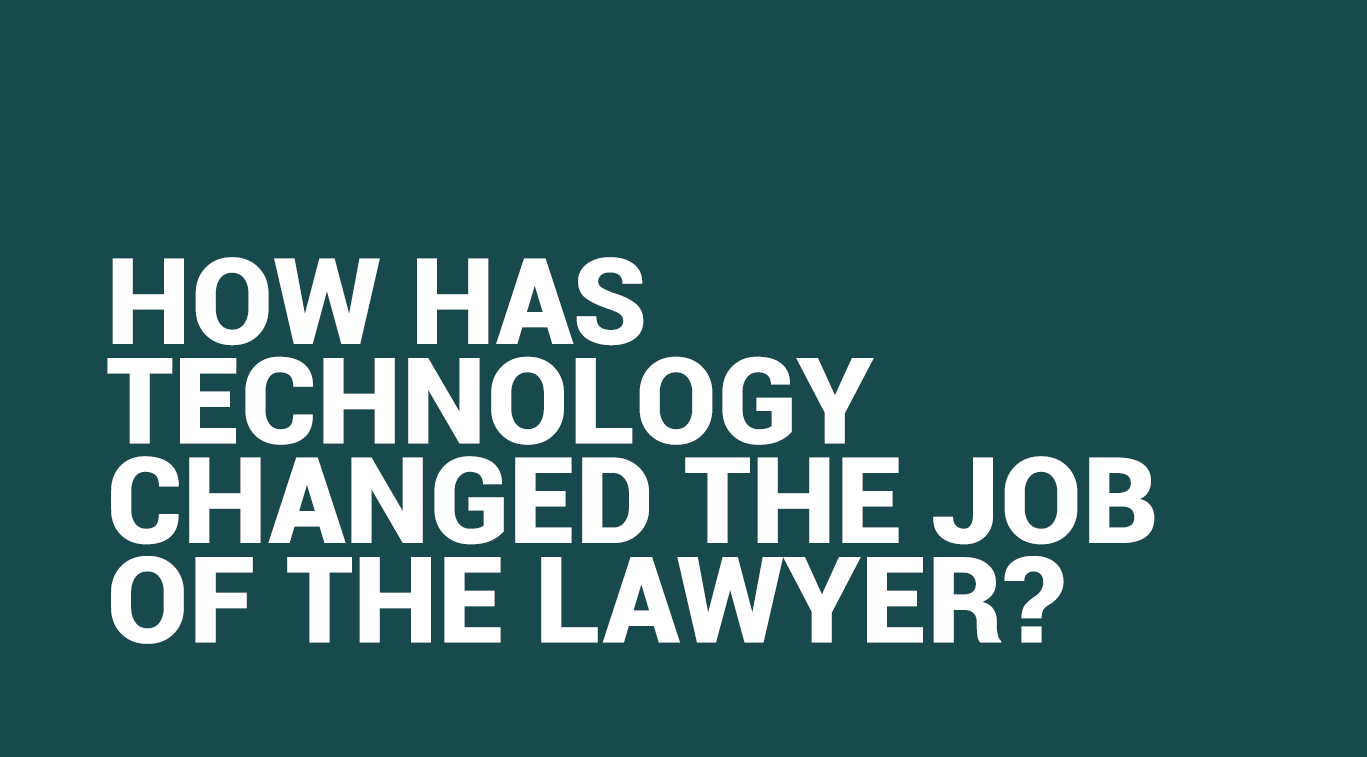Solving Legal Brain Drain with Legal Tech

Written by Joshua Fraser
Blogger

Workplace management, in some form or another, has been a concern of modern humans ever since the first farmers settled in the fertile crescent and began utilising agriculture. Since the industrial revolution, the need for effective management has proliferated to resemble something similar to the hierarchical and management structures we see today.
However, in today’s evermore pressurised and workload heavy office spaces, the need for employee management is more essential than ever before. Modern managers are expected to lead by example, create a healthy work environment and crucially ensure their departments deliver the requisite projects in their specified timeframes. This has proved to be a considerable challenge for modern workplace managers, who are more and more overworked. Consequently, they find themselves unable to meet all the demands expected of them, without sacrificing some elements, such as employee satisfaction.
Such challenges are occurring across the modern professional landscape and nowhere more so than in the legal sector, where legal professionals are burning out at record rates. Indeed, 63% of legal professionals report feeling stressed as a result of their job. This provides a challenge for legal practice managers, whether they be small to large firm partners, In-house legal department heads or legal heads of corporate bodies – who are making significant inroads in entering into the legal field.
Not only do stressed employees leave those managing them with considerable feelings of guilt, as a consequence of the stress they are placing on their colleagues. Such atmospheres of workplace pressure can lead to lower rates of productivity, meaning that such a culture of workspace attrition offers little to no net benefits for any given party.
Moreover, as many lawyers are likely aware, stress in the workplace can even result in lawsuits. In the UK this precedent was most saliently established in the case of Barber v Somerset County Council, where a teacher, notably a profession 12% less stressful than the law on average, successfully sued his employer for £72.547.02 for placing excessive work-related stress on him during the course of his occupational duties.
The House of Lords held that employers owe an assumed duty of care and responsibility to their employees. This is often widely known and expected when it comes to physical injury in the workplace. However, it is less well known that workers can claim for stress based psychiatric harm incurred during the course of their employment.
While the test for employer’s liability in regards to workplace caused, stress induced, psychiatric harm is not straightforward or clearcut, there is are practical propositions, which were formulated by the former Supreme Court president Lady Hale, and cited by Lord Scott, which provide a guidebook for assessing whether a specific employee has been unduly and unlawfully subjected to workplace stress, which would result in the employer being judged to have fallen below their requisite duty of care owed to the employee.
At a glance, these include assessing whether:
- The quality or quantity of the work being undertaken by the employee in question is far in excess of the normal workload for a person in such a position, such that it might exact a greater emotional or intellectual toll on the individual than normally seen in such a position.
- That the employee exhibited outward signs of stress that indicated they were suffering harm to their mental or physical health, and that these signs were plain or obvious enough that their employer should have noticed them.
- The size and scope of the employing business or entity allowed for sufficient resources to directly aid the employee directly or at least ameliorate the pressure of their situation.
Using these criteria and the contextual relationship between the employee and the employer a court will consider overall whether the psychiatric harm and occupational stress suffered by the employee was reasonably foreseeable to the employer.
Once the court holds this threshold to have been crossed, they will most likely hold the offending employer to be liable in damages for the stress induced psychiatric injury to their employees.
These criteria are particularly interesting, as they seemingly strive to set an industry-specific benchmark against which the occupational stress of an employee can be measured. Indeed, amongst these criteria is the provision that this test is the same no matter the field of employment, meaning that there are no occupations that should or are considered by courts to be intrinsically dangerous to their employees’ mental health.
Ostensibly, this would mean that careers, such as law, are usually not amenable to this test, as often the quantity of work being undertaken by lawyers of all levels is roughly comparable to a relatively hectic and heavy industry standard.
Moreover, one might think that law firms, with their high-paying salaries and large profits, could easily divert resources to struggling legal professionals in their employ, as in line with the third criteria above. However, such a notion is defeated by three restrictions.
Firstly, the third criteria comes with the caveat that any diversion of resources must not have the net effect of detrimental another employee in a similar or serious way. Secondly, such an assumption neglects that unfortunately all law firms are experiencing the legal services boom of recent years. Indeed, some smaller firms have even seen reductions in their profits in 2021, another symptom of the more-for-less challenge.
Finally, and thirdly, when workplace stress is as widespread as all reports show, in the legal sector, then most if not all attempts to lessen the pressure on one legal employee will inevitably result in shifting the burden of pressure to another.
Consequently and somewhat ironically, it is unlikely that lawyers will benefit much from the conventional test set out for occupational stress claims.
What is The Impact of Such Industry-wide Pressure?
When 7 out of 10 legal workers claim that their job negatively impacts their mental health, it is inevitable that some wide-ranging knock-on consequences will materialise.
Today the most striking consequence of workplace stress in the legal sector is the number of legal professionals exiting the profession of law, with as many as over a third (37%) of legal professionals having considered quitting their jobs due to the effect it has on their mental health.
This stress engendered brain drain, or loss of legal talent to other less pressurised sectors, is something that has been cited as a leading cause of ‘lawyer loss’ in as prominent texts as The Secret Barrister, as a reason behind the best and brightest leaving the law behind.
In 2018, at the time of the secret Barrister’s publication, many dismissed such concerns as confined to areas of the law, such as Criminal law, most affected by the sharp curtailment of legal aid by the LAPSO 2012 act. As prevailing wisdom at the time held that workplace stress is only detrimental when not offset by generous remuneration packages.
However, such understanding has been challenged by recent law firm wage wars over newly qualified lawyer salaries, specifically in the commercial sector. Crucially, the rapidly proliferating salaries for lawyers in these sectors reflect the sector wide challenge of retaining legal professionals.
As more and more skilled lawyers, of associate-level equivalent, leave the legal profession, a battle is ensuing to retain those who remain, not only to make certain that firms still function, but that there are sufficiently experienced lawyers in place to train and support the trainees, who themselves are feeling the pressure.
The price for keeping individuals working in these conditions is an ever more generous pay package, but one that is not necessarily sustainable.
What Causes All this Workplace Stress?
The leading cause of workplace stress is workload. Moreover, this workload is often considered, by those suffering from burnout as a result of it, to be the result of factors intrinsic to the job, meaning that, in the vast majority of cases, these effects are not external to the given position those suffering find themselves in, nor are they therefore transitory causes.
This is no different in law, as the principal causes cited behind burnout are heavy caseloads, demanding clients and tight deadlines. While there are calls to reform non-technical elements of legal workplaces, such as cultures of overworking and bottling up, it seems clear that the prime drive behind lawyers’ workplace stress is practical, as opposed to attitudinal.
How to Solve Brain Drain From the Legal Sector:
There are many potential solutions for stopping legal sector brain drain. However, the most compelling often revolve around improving systems of operation inside of legal practices, as opposed to the broad ulterior option of placing hard limits on the amount of work, and therefore profitability, individual lawyers engage in.
Legal practices today would stand best served to employ legal Software systems to solve the stress-related occupational issues facing their learned employees. Specifically, UK law practice software offers a remedy in the form of legal practice management solutions or systems.
Legal practice management systems is the umbrella term given to a selection of legal tech features and applications, taken holistically, that can enhance the way in which a practice is run. Typically, a Legal practice management system will include three specific categories of the program;
1.Legal practice HR software
2.Legal practice analytics software
3.Legal Manager software
These elements combine to allow rounded managerial oversight over a team of legal professionals, or indeed an entire legal practice. While it is possible to discuss these subcategories of legal practice management software in abstract principle, it is most illuminating to provide examples of their utility in a functional legal tech system.
Fortunately, Good Law Software or GLS’s legal tech system possesses a dedicated legal practice management element, replete with each of these functionalities.
Management Software:
For example, GLS’s Case Management tool works to provide an agile, efficient and easy to use platform for reviewing current, previous and upcoming cases, which can be used at an individual employee level, or as a managerial overview. This built-in system functions to automate time-consuming administrative tasks, such as form filling, with greater accuracy, therefore less need for re-checking, and an inherently quicker completion rate. This saves employees time, resultantly lowering their workload in terms of hours utilised on a given task.
Furthermore, this case management tool is seamlessly integrated with teams to allow for improved productivity holistically throughout multiple firm departments, allowing an economy of scale to take effect and further decrease the concurrent workload within the legal practice.
Even when it comes to closing accounts
HR & Analytics:
While these two elements can be divided in principle, they are inherently interconnected within the GLS suite, and also overlap with other managerial elements. In order for a legal firm’s HR arm to make use of legal HR software they have to be able to consider the performance of the firm at both an individual and aggregate level.
GLS’s Staff Performance Reporting feature enables a manager to track cases and elements through their life cycle in the GLS system. Specifically, this allows for detailed analysis and detection of any bottlenecks or snagging points in the firm. This can be useful not only for identifying productivity pain points, from a managerial perspective, but also allows for employee activity to be analysed for detection of departments or individuals who are under particular stress or difficulty. This will allow a firm to take greater steps to help restructure and reshape the workflow to better balance out the amount of pressure on any given practitioner.
Conclusion:
As with many other pain points, technology in the legal sector stands to depressurise and ameliorate the overly-hectic and stressful lives of lawyers. A firm that employs legal tech to mitigate the stress placed on its employees will reduce the likelihood of their resignation. In turn, the need to aggressively financially compete with other firms to acquire and retain legal talent will be lessened, due to a decreased staff-turn over.
References
-
[1] ‘Stress and Mental Health’, The Law Society at https://www.lawsociety.org.uk/en/career-advice/career-development/stress-and-mental-health
[2] Toh Yong Chuan, Brain drain of Younger Lawyers a Worrying Trend as S’pore Grows Legal Sector’, https://www.straitstimes.com/singapore/on-the-ground-brain-drain-of-younger-lawyers-a-worrying-trend-as-spore-grows-legal-sector
[3] ‘Employment Law – Stress at Work’, at https://landaulaw.co.uk/stress-at-work/
[4] Philip Landau, ‘Dealing with Workplace Stress – your legal rights’ at ‘https://www.theguardian.com/careers/careers-blog/dealing-with-workplace-stress-your-legal-rights’
[5] Harry Cerasale, ‘Are Lawyers being paid too much?’ at https://www.chambersstudent.co.uk/where-to-start/commercial-awareness-info/market-analysis/salary-wars-are-lawyers-being-paid-too-much
[6] John Hyde ‘Salary war goes on as firm moves NQs onto £161,500 a year’ https://www.lawgazette.co.uk/news/salary-war-goes-on-as-firm-moves-nqs-onto-161500-a-year/5111286.article
[7] Elad N. Sherf, Et al,‘Research: When Managers Are Overworked, They Treat Employees Less Fairly’, Harvard Business Review at https://hbr.org/2018/06/research-when-managers-are-overworked-they-treat-employees-less-fairly
[8] ‘Law Firms Changing Structure’, Universal Class at https://www.universalclass.com/articles/business/law-firms-changing-structure.html
[9] ‘The Barriers to Change in Law Firms’, Litera at https://www.litera.com/the-changing-lawyer/the-barriers-to-change-in-law/
[10] ‘The Importance of Technology in the Workplace’, Nova at https://n-o-v-a.com/blog/the-importance-of-technology-in-the-workplace/#:~:text=Technology%20helps%20in%20keeping%20the,in%20keeping%20everything%20on%20track.








